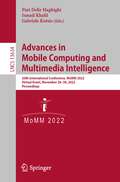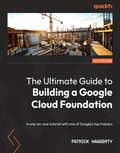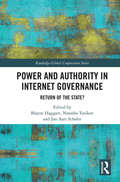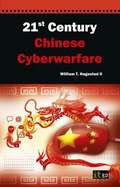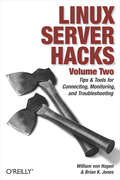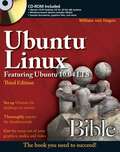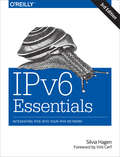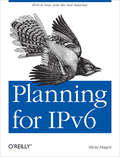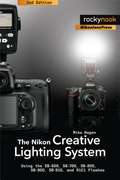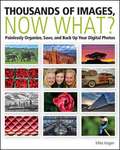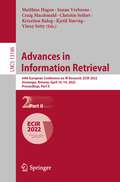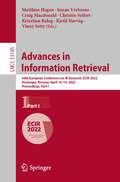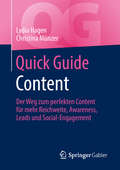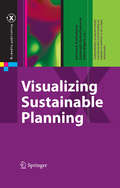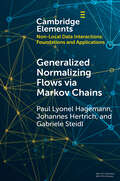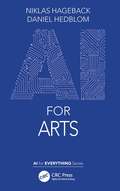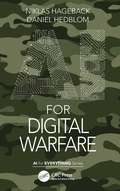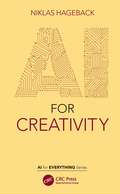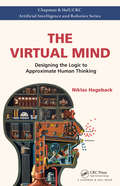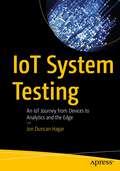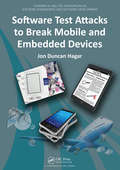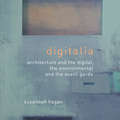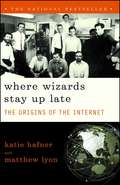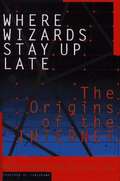- Table View
- List View
Advances in Mobile Computing and Multimedia Intelligence: 20th International Conference, MoMM 2022, Virtual Event, November 28–30, 2022, Proceedings (Lecture Notes in Computer Science #13634)
by Pari Delir Haghighi Ismail Khalil Gabriele KotsisThis volume includes the papers presented at the 20th International Conference on Advances in Mobile Computing & Multimedia Intelligence (MoMM2022), organized in conjunction with 24th International Conference on Information Integration and Web Intelligence. The dominant research focus of submitted papers was artificial intelligence and machine learning. The accepted papers presented advances and innovations in an array of areas such as online teaching, activity and movement detection, greenhouse gas emission, smart irrigation, network security, and video delivery. MoMM2022 attracted 34 papers, from which the Program Committee selected 8 regular papers and 8 short papers.Due to safety concerns as well as other restrictions preventing travel and gatherings, it was decided to organize MoMM2022 as a virtual conference.
The Ultimate Guide to Building a Google Cloud Foundation: A one-on-one tutorial with one of Google's top trainers
by Patrick HaggertyFollow Google's own ten-step plan to construct a secure, reliable, and extensible foundation for all your Google Cloud base infrastructural needsKey FeaturesBuild your foundation in Google Cloud with this clearly laid out, step-by-step guideGet expert advice from one of Google's top trainersLearn to build flexibility and security into your Google Cloud presence from the ground upBook DescriptionFrom data ingestion and storage, through data processing and data analytics, to application hosting and even machine learning, whatever your IT infrastructural need, there's a good chance that Google Cloud has a service that can help. But instant, self-serve access to a virtually limitless pool of IT resources has its drawbacks. More and more organizations are running into cost overruns, security problems, and simple "why is this not working?" headaches. This book has been written by one of Google's top trainers as a tutorial on how to create your infrastructural foundation in Google Cloud the right way. By following Google's ten-step checklist and Google's security blueprint, you will learn how to set up your initial identity provider and create an organization. Further on, you will configure your users and groups, enable administrative access, and set up billing. Next, you will create a resource hierarchy, configure and control access, and enable a cloud network. Later chapters will guide you through configuring monitoring and logging, adding additional security measures, and enabling a support plan with Google. By the end of this book, you will have an understanding of what it takes to leverage Terraform for properly building a Google Cloud foundational layer that engenders security, flexibility, and extensibility from the ground up.What you will learnCreate an organizational resource hierarchy in Google CloudConfigure user access, permissions, and key Google Cloud Platform (GCP) security groupsConstruct well thought out, scalable, and secure virtual networksStay informed about the latest logging and monitoring best practicesLeverage Terraform infrastructure as code automation to eliminate toilLimit access with IAM policy bindings and organizational policiesImplement Google's secure foundation blueprintWho this book is forThis book is for anyone looking to implement a secure foundational layer in Google Cloud, including cloud engineers, DevOps engineers, cloud security practitioners, developers, infrastructural management personnel, and other technical leads. A basic understanding of what the cloud is and how it works, as well as a strong desire to build out Google Cloud infrastructure the right way will help you make the most of this book. Knowledge of working in the terminal window from the command line will be beneficial.
Power and Authority in Internet Governance: Return of the State? (Routledge Global Cooperation Series)
by Blayne Haggart Natasha Tusikov Jan Aart ScholtePower and Authority in Internet Governance investigates the hotly contested role of the state in today's digital society. The book asks: Is the state "back" in internet regulation? If so, what forms are state involvement taking, and with what consequences for the future? The volume includes case studies from across the world and addresses a wide range of issues regarding internet infrastructure, data and content. The book pushes the debate beyond a simplistic dichotomy between liberalism and authoritarianism in order to consider also greater state involvement based on values of democracy and human rights. Seeing internet governance as a complex arena where power is contested among diverse non-state and state actors across local, national, regional and global scales, the book offers a critical and nuanced discussion of how the internet is governed – and how it should be governed. Power and Authority in Internet Governance provides an important resource for researchers across international relations, global governance, science and technology studies and law as well as policymakers and analysts concerned with regulating the global internet.
21st Century Chinese Cyberwarfare
by William T. Hagestad II21st Century Chinese Cyberwarfare draws from a combination of business, cultural, historical, linguistic and the author s personal experience to attempt to explain China to the uninitiated. The objective of the book is to raise awareness of the fact that the People's Republic of China is using a combination of their unique culture, language, and political will, known as Chinese Communism, to maintain their cultural heritage. This book is the first to gather the salient information regarding the use of cyber warfare doctrine by the People's Republic of China to promote its own hegemonistic, national self-interests and enforce its political, military and economic will on other nation states. The threat of Chinese Cyberwarfare can no longer be ignored. It is a clear and present danger to the experienced and innocent alike and will be economically, societally and culturally changing and damaging for the nations that are targeted.
Linux Server Hacks, Volume Two
by William Von Hagen Brian K. JonesToday's system administrators deal with a vast number of situations, operating systems, software packages, and problems. Those who are in the know have kept their copy of Linux Server Hacks close at hand to ease their burden. And while this helps, it's not enough: any sys admin knows there are many more hacks, cool tips, and ways of solving problems than can fit in a single volume (one that mere mortals can lift, that is). Which is why we created Linux Server Hacks, Volume Two, a second collection of incredibly useful tips and tricks for finding and using dozens of open source tools you can apply to solve your sys admin problems. The power and flexibility of Linux and Open Source means that there is an astounding amount of great software out there waiting to be applied to your sys admin problems -- if only you knew about it and had enough information to get started. Hence, Linux Server Hacks, Volume Two. This handy reference offers 100 completely new server management tips and techniques designed to improve your productivity and sharpen your administrative skills. Each hack represents a clever way to accomplish a specific task, saving you countless hours of searching for the right answer. No more sifting through man pages, HOWTO websites, or source code comments -- the only resource you need is right here. And you don't have to be a system administrator with hundreds of boxen to get something useful from this book as many of the hacks apply equally well to a single system or a home network. Compiled by experts, these hacks not only give you the step-by-step instructions necessary to implement the software, but they also provide the context to truly enable you to learn the technology. Topics include: Authentication Remote GUI connectivity Storage management File sharing and synchronizing resources Security/lockdown instruction Log files and monitoring Troubleshooting System rescue, recovery, and repair Whether they help you recover lost data, collect information from distributed clients, or synchronize administrative environments, the solutions found in Linux Server Hacks, Volume Two will simplify your life as a system administrator.
Ubuntu Linux Bible
by William Von HagenThe best resource on the very latest for Ubuntu users!Ubuntu is a free, open-source, Linux-based operating system that can run on desktops, laptops, netbooks, and servers. If you've joined the millions of users around the world who prefer open-source OS-and Ubuntu in particular-this book is perfect for you. It brings you the very latest on Ubuntu 10.04, with pages of step-by-step instruction, helpful tips, and expert techniques.Coverage Includes:The Ubuntu Linux ProjectInstalling UbuntuInstalling Ubuntu on Special-Purpose Systems Basic Linux System ConceptsUsing the GNOME Desktop Using the Compiz Window Manager Managing E-Mail and Personal Information with EvolutionSurfing the Web with FirefoxMigrating from Windows SystemsSending and Receiving Instant MessagesUsing Command-Line Tools Working with Text FilesCreating and Publishing Documents Other Office Software: Spreadsheets and Presentations Working with GraphicsWorking with MultimediaConsumer Electronics and Ubuntu Adding, Removing, and Updating SoftwareAdding Hardware and Attaching PeripheralsNetwork Configuration and SecurityGoing WirelessSoftware Development on Ubuntu Using Virtual Machines and EmulatorsConnecting to Other SystemsFile Transfer and SharingManaging Users, Groups, and AuthenticationBacking Up and Restoring FilesSetting Up a Web Server Setting Up a Mail Server Setting Up a DHCP ServerSetting Up a DNS ServerSetting Up a Print ServerSetting Up an NFS ServerUp a Samba ServerUpdating your Ubuntu? Ubuntu Linux Bible, Third Edition, is the book you need to succeed!Note: CD-ROM is not included as part of eBook file.
IPv6 Essentials 3rd Edition
by Silvia HagenIPv6 Essentials, Second Edition provides a succinct, in-depth tour of all the new features and functions in IPv6. It guides you through everything you need to know to get started, including how to configure IPv6 on hosts and routers and which applications currently support IPv6. The new IPv6 protocols offers extended address space, scalability, improved support for security, real-time traffic support, and auto-configuration so that even a novice user can connect a machine to the Internet. Aimed at system and network administrators, engineers, network designers, and IT managers, this book will help you understand, plan for, design, and integrate IPv6 into your current IPv4 infrastructure. Beginning with a short history of IPv6, author Silvia Hagen provides an overview of new functionality and discusses why we need IPv6. Hagen also shares exhaustive discussions of the new IPv6 header format and Extension Headers, IPv6 address and ICMPv6 message format, Security, QoS, Mobility and, last but not least, offers a Quick Start Guide for different operating systems. IPv6 Essentials, Second Edition also covers: In-depth technical guide to IPv6 Mechanisms and Case Studies that show how to integrate IPv6 into your network without interruption of IPv4 services Routing protocols and upper layer protocols Security in IPv6: concepts and requirements. Includes the IPSEC framework and security elements available for authentication and encryption Quality of Service: covers the elements available for QoS in IPv6 and how they can be implemented Detailed discussion of DHCPv6 and Mobile IPv6 Discussion of migration cost and business case Getting started on different operating systems: Sun Solaris, Linux, BSD, Windows XP, and Cisco routersWhether you're ready to start implementing IPv6 today or are planning your strategy for the future, IPv6 Essentials, Second Edition will provide the solid foundation you need to get started. "Silvia's look at IPv6 is always refreshing as she translates complex technology features into business drivers and genuine end-user benefits to enable building new business concepts based on end to end models." Latif Ladid, President IPv6 Forum, Chair EU IPv6 Task Force
Planning for IPv6: IPv6 Is Now. Join the New Internet.
by Silvia Hagen<p>With IPv4 network addresses close to depletion, moving to IPv6 is now business critical. This concise book helps you plan for IPv6 integration by providing a high-level overview of the technical and non-technical steps involved. Protocol analysis and directory service expert Silvia Hagen—author of <i>IPv6 Essentials</i>—supplies answers to the issues most frequently discussed by her clients. With this guide, project leaders and planning team members learn how to develop a cohesive IPv6 strategy.</p>
White Space is Not Your Enemy
by Rebecca Hagen Kim GolombiskyDesigning a brochure or web site without an art background? Step away from the computer and read this breezy introduction to visual communications first. Written for non-designers, White Space is Not Your Enemy is a practical graphic design and layout text introducing the concepts and practices necessary for producing effective visual communications across a variety of formats, from print to Web.This beautifully illustrated, full-color book covers the basics to help you develop your eye and produce attractive work. Topics include:* The basics of effective design that communicates its intended message* Pre-design planning* 13 Layout Sins to avoid* Basic typography* Working with color* Storyboarding for video, Web, and presentions* Information graphics* Mini Art School--all the basics in one chapter* Outputting your work
The Nikon Creative Lighting System
by Mike HagenMike Hagen opens up a whole new world to those photographers who are already well versed in photography, but may not have a clue about flash photography. With the new and rapidly evolving technology, flash photography (especially advanced light modeling with modern iTTL flash systems) has become an art in itself and should be mastered by all aspiring photographers-amateurs as well as professionals-who are often helpless when it comes to using the full potential of these systems. Using a simple, step-by-step method for setting up and using the newest Nikon iTTL flash units, Mike teaches all the steps required to achieve consistent and amazing flash photos. He solves the common frustrations associated with flash, and specifically teaches how to use the SB-600, SB-700, SB-800, SB-900, SB-910, and R1C1 strobes. Also included is a chapter showing system configuration so readers can duplicate the desired results on their own. Beginning at a basic level and progressing to more advanced techniques, Mike teaches you everything you need to know about mastering Nikon's iTTL flash system.
Thousands of Images, Now What
by Mike HagenTackle the challenges of digital photo file management!If you find yourself with more digital photos than you know what to do with or at a loss as to how to begin organizing them all, then Digital Asset Management (DAM) is your solution. This incredibly helpful book answers such common questions as: how should I manage the sheer volume of images? How can I make sure my pictures are safely backed-up? How can I efficiently categorize my images so that I can quickly find the one I'm seeking? Professional photographer and author Mike Hagen shows you how to organize, save, and back-up your digital photos by creating a filing and back-up system that are both efficient and effective. He walks you through the steps necessary to successfully maintain an orderly archiving system so that you can quickly store, save, and retrieve your images. Digital Asset Management (DAM) helps you organize, save, and back-up your digital photosExplains how to efficiently and effectively create an intuitive filing system that is right for you Answers frequently asked questions regarding storing, saving, and retrieving imagesEncourages you to create a successful digital photo archive that, once created, will be easy to maintain and use Say "so long" to your days of being a digital photo pack rat when you put this easy-to-understand, helpful book to use!
Advances in Information Retrieval: 44th European Conference on IR Research, ECIR 2022, Stavanger, Norway, April 10–14, 2022, Proceedings, Part II (Lecture Notes in Computer Science #13186)
by Matthias Hagen Suzan Verberne Craig Macdonald Christin Seifert Krisztian Balog Kjetil Nørvåg Vinay SettyThis two-volume set LNCS 13185 and 13186 constitutes the refereed proceedings of the 44th European Conference on IR Research, ECIR 2022, held in April 2022, due to the COVID-19 pandemic. The 35 full papers presented together with 11 reproducibility papers, 13 CLEF lab descriptions papers, 12 doctoral consortium papers, 5 workshop abstracts, and 4 tutorials abstracts were carefully reviewed and selected from 395 submissions.Chapter “Leveraging Customer Reviews for E-commerce Query Generation” of this book is available open access under a CC BY 4.0 license.
Advances in Information Retrieval: 44th European Conference on IR Research, ECIR 2022, Stavanger, Norway, April 10–14, 2022, Proceedings, Part I (Lecture Notes in Computer Science #13185)
by Matthias Hagen Suzan Verberne Craig Macdonald Christin Seifert Krisztian Balog Kjetil Nørvåg Vinay SettyThis two-volume set LNCS 13185 and 13186 constitutes the refereed proceedings of the 44th European Conference on IR Research, ECIR 2022, held in April 2022, due to the COVID-19 pandemic. The 35 full papers presented together with 11 reproducibility papers, 13 CLEF lab descriptions papers, 12 doctoral consortium papers, 5 workshop abstracts, and 4 tutorials abstracts were carefully reviewed and selected from 395 submissions.
Quick Guide Content: Der Weg zum perfekten Content für mehr Reichweite, Awareness, Leads und Social-Engagement (Quick Guide)
by Lydia Hagen Christina MünzerLernen Sie in diesem Content-Marketing-Buch, wie Sie überzeugende Inhalte für Ihre Webseite erstellenDieser „Quick Guide Content“ unterstützt Sie optimal dabei, überzeugende Inhalte im Content-Marketing zu erstellen. Content und SEO in Einklang zu bringen, ist heute eine zentrale und zugleich anspruchsvolle Aufgabe im Content-Marketing. Unternehmen, Online-Journalisten, Blogger und Redakteure müssen ihre Zielgruppe in nur wenigen Sekunden auf sich aufmerksam machen, um sich von ihren Wettbewerbern abzuheben. Hierfür stehen sie vor der Herausforderung, Inhalte zu schaffen, die einen tiefen Informationsgehalt garantieren und gleichzeitig schnell konsumierbar sind. Dieser praxiserprobte Leitfaden begleitet Sie dabei, gute Inhalte zu erstellen und sie erfolgreich zu verbreiten. Kompaktes und umsetzungsorientiertes WissenDamit Sie Ihre Inhalte zielgruppenspezifisch ausrichten und verbreiten können, müssen Sie zunächst die Notwendigkeit der Content-Erstellung und -Optimierung sowie die weiteren Schritte des Content-Managements verstehen. Hierfür liefert Ihnen der „Quick Guide Content“ schnell erschließbares, kompaktes und umsetzungsorientiertes Wissen. Sie erhalten verlässliche Fachinformationen, um mitreden, fundiert entscheiden und direkt handeln zu können. Mit Hilfe dieses praktischen Content-Marketing-Buchs gelingt Ihnen eine kontinuierliche Steigerung der Reichweite, Awareness und Conversion für Ihre beworbene Marke.Anschauliche Praxisbeispiele und nützliche Tool-TippsFundierte Zielgruppenanalysen und Themenrecherchen, die sich am Nutzerbedürfnis orientieren, sind relevant für die Erstellung von reichweitenstarkem Content. Sie müssen in jeder Stufe der Content-Erstellung und in den Phasen der Customer Journey die Suchmaschinenoptimierung (SEO) im Blick behalten. Nur so ist sichergestellt, dass Ihre Zielgruppe Ihre Inhalte auch finden kann. Anhand zahlreicher praxisnaher Beispiele (inkl. Tool-Tipps) erläutern die Autorinnen in ihrem Werk, wie Sie bei der Content-Implementierung in Ihrer Firma am besten vorgehen: Welchen Weg gibt es zum perfekten Content (Strategie, Audit, Recherchen etc.)?Wie stellen sich die Ressourcen für die zielgerichtete Umsetzung dar? Welche Themenpotenziale stehen Ihrem Unternehmen für die Umsetzung bereit? Wie und über welche Kanäle lassen sich die Inhalte verbreiten? Welche sind die richtigen KPIs im Content Marketing?Die Autorinnen begleiten Sie in diesem Content-Marketing-Buch Schritt für Schritt beim Content-Aufbau für Ihre Website.
Visualizing Sustainable Planning
by Hans Hagen Subhrajit Guhathakurta Gerhard SteinebachThe authors present the state of the art in the rapidly growing field of visualization as related to problems in urban and regional planning. The significance and timeliness of this volume consist in its reflection of several developments in literature and the challenges cities are facing. First, the unsustainability of many of our current paradigms of development has become evidently clear. We are entering an era in which communities across the globe are strengthening their connections to the global flows of capital, goods, ideas, technologies and values while facing at the same time serious dislocations in their traditional socioeconomic structures. While the impending scenarios of climate change impacts remind us about the integrated ecological system that we are part of, the current discussions about global recession in the media alert us and make us aware of the occasional perils of the globalized economic system. The globally dispersed, intricately integrated and hyper-complex socioeconomic-ecological system is difficult to analyze, comprehend and communicate without effective visualization tools. Given that planners are at the frontlines in the effort to prepare as well as build resilience in the impacted communities, appropriate visualization tools are indispensable for effective planning. Second, planners have largely been slow to incorporate the advances in visualization research emerging from other domains of inquiry.
Generalized Normalizing Flows via Markov Chains (Elements in Non-local Data Interactions: Foundations and Applications)
by Paul Lyonel Hagemann Johannes Hertrich Gabriele SteidlNormalizing flows, diffusion normalizing flows and variational autoencoders are powerful generative models. This Element provides a unified framework to handle these approaches via Markov chains. The authors consider stochastic normalizing flows as a pair of Markov chains fulfilling some properties, and show how many state-of-the-art models for data generation fit into this framework. Indeed numerical simulations show that including stochastic layers improves the expressivity of the network and allows for generating multimodal distributions from unimodal ones. The Markov chains point of view enables the coupling of both deterministic layers as invertible neural networks and stochastic layers as Metropolis-Hasting layers, Langevin layers, variational autoencoders and diffusion normalizing flows in a mathematically sound way. The authors' framework establishes a useful mathematical tool to combine the various approaches.
AI for Arts (AI for Everything)
by Niklas Hageback Daniel HedblomAI for Arts is a book for anyone fascinated by the man–machine connection, an unstoppable evolution that is intertwining us with technology in an ever-greater degree, and where there is an increasing concern that it will be technology that comes out on top. Thus, presented here through perhaps its most esoteric form, namely art, this unfolding conundrum is brought to its apex. What is left of us humans if artificial intelligence also surpasses us when it comes to art? The articulation of an artificial intelligence art manifesto is long overdue, so hopefully this book can fill a gap that will have repercussions not only for aesthetic and philosophical considerations but possibly more so for the development of artificial intelligence.
AI for Digital Warfare (AI for Everything)
by Niklas Hageback Daniel HedblomAI for Digital Warfare explores how the weaponising of artificial intelligence can and will change how warfare is being conducted, and what impact it will have on the corporate world. With artificial intelligence tools becoming increasingly advanced, and in many cases more humanlike, their potential in psychological warfare is being recognised, which means digital warfare can move beyond just shutting down IT systems into more all-encompassing hybrid war strategies.
AI for Creativity (AI for Everything)
by Niklas HagebackWhat is computational creativity? Can AI learn to be creative? One of the human mind’s most valuable features is the capacity to formulate creative thoughts, an ability that through quantum leap innovations has propelled us to the current digital age. However, creative breakthroughs are easier said than done. Appearing less frequently and more sporadically than desired, it seems that we have not yet fully cracked the creative code. But with the rapid advances in artificial intelligence which have come to provide an ever-closer proximity with the cognitive faculties of mankind, can this emerging technology improve our creative capabilities? What will that look like and will it be the missing link in the man–machine enigma? AI for Creativity provides a fascinating look at what is currently emerging in the very cutting-edge area of artificial intelligence and the tools being developed to enable computational creativity that holds the propensity to dramatically change our lives.
The Virtual Mind: Designing the Logic to Approximate Human Thinking (Chapman & Hall/CRC Artificial Intelligence and Robotics Series)
by Niklas HagebackThe Virtual Mind: Designing the Logic to Approximate Human Thinking, through an in-depth and multidisciplinary review, outlines and defines the underpinnings for modelling human thinking through approximating the mind. Whilst there are plenty of efforts underway trying to mimic the brain, its complexities have so far proven insurmountable. But replicating the abstract notion of the mind provides a viable and quicker route. Broadly, the mind consists of a conscious and an unconscious part with separate logic schemes and these absorbs reality in diverging chunks, with the former truncated through narratives and norms and the latter able to amass broader perceptions of reality. These are held together and controlled through a governing mechanism. With the replication and establishment of the mind’s mechanistic rules and dynamic constants, tested through a big data approach from public media, it allows for standardization and machine generated human thinking, a Virtual Mind.A virtual mind is able to cover a wide array of applications, in particular forecasting of human behavior and decision-making. In essence, the whole socioeconomic spectra can be captured, including politics, financial markets and consumer patterns. Another area of potential application would be to augment various game software and of course, it would be applicable for the man-machine connect.The book guides the reader on how to develop and produce a machine generated virtual mind in a step-by-step manner. It is a must for anyone with an interest in artificial intelligence, the design and construction of the next generation of computer logic and it provides an enhanced understanding of mankind’s greatest mystery, the workings of the mind. Niklas Hageback has extensive experience of risk modelling and financial analytics working at tier-one financial institutions and consulting firms, such as Deutsche Bank, KPMG, and Goldman Sachs, where he held regional executive risk management and oversight roles in both Europe and Asia.
IoT System Testing: An IoT Journey from Devices to Analytics and the Edge
by Jon Duncan HagarTo succeed, teams must assure the quality of IoT systems. The world of technology continually moves from one hot area to another; this book considers the next explosion—of IoT—from a quality testing viewpoint. You'll first gain an introduction to the Internet of Things (IoT), V&V, and testing. Next, you'll be walked through IoT test planning and strategy over the full life cycle, including the impact of data analytics and AI. You will then delve deeper into IoT security testing and various test techniques, patterns, and more. This is followed by a detailed study of IoT software test labs, architecture, environments and AI. There are many options for testing IoT qualities based on the criticality of the software and risks involved; each option has positives, negatives, as well as cost and schedule impacts. The book will guide start-up and experienced teams into these paths and help you to improve the testing and quality assessment of IoT systems. What You Will LearnUnderstand IoT software test architecture and planningMaster IoT security testing and test techniquesStudy IoT test lab automation and architecturesReview the need for IoT security, data analytics, AI, Neural Networks and dependability using testing and V&V Who This Book Is ForReaders with basic knowledge of software development who want to learn more about IoT testing and its intricacies, as well as companies moving into the domain of IoT, and even those already deep into the IoT domain will benefit from this book.
Software Test Attacks to Break Mobile and Embedded Devices: Software Test Attacks To Break Mobile And Embedded Devices (Chapman And Hall/crc Innovations In Software Engineering And Software Development Ser. #6)
by Jon Duncan HagarAddress Errors before Users Find ThemUsing a mix-and-match approach, Software Test Attacks to Break Mobile and Embedded Devices presents an attack basis for testing mobile and embedded systems. Designed for testers working in the ever-expanding world of "smart" devices driven by software, the book focuses on attack-based testing that can be used by
Digitalia: Architecture and the Digital, the Environmental and the Avant-Garde
by Susannah HaganSusannah Hagan boldly discusses the fraught relationship between key dominating areas of architectural discourse - digital design, environmental design, and avant-garde design.Digitalia firstly demonstrates that drawing such firm lines between architectural spheres is damaging and foolish, particularly as both environmental and avant-garde practices are experimenting with the digital, and secondly remonstrates with an avant-garde that has repudiated the social/ethical agenda of the modernist avant-garde because it failed the first time round. It is environmental architecture that has picked up the social/ethical ball and is running with it, using the digital to very different, and more far-reaching, ends.As the debates rage, this book is a key read for all who are involved or intrigued.
Where Wizards Stay Up Late: The Origins Of The Internet
by Katie Hafner Matthew LyonTwenty five years ago, it didn't exist. Today, twenty million people worldwide are surfing the Net. Where Wizards Stay Up Late is the exciting story of the pioneers responsible for creating the most talked about, most influential, and most far-reaching communications breakthrough since the invention of the telephone. In the 1960's, when computers where regarded as mere giant calculators, J.C.R. Licklider at MIT saw them as the ultimate communications devices. With Defense Department funds, he and a band of visionary computer whizzes began work on a nationwide, interlocking network of computers. Taking readers behind the scenes, Where Wizards Stay Up Late captures the hard work, genius, and happy accidents of their daring, stunningly successful venture.
Where Wizards Stay Up Late: The Origins of the Internet
by Katie Hafner Matthew Lyon"A little more than twenty-five years ago, computer networks did not exist anywhere - except in the minds of a handful of computer scientists. In the late 1960s, the Defense Department's Advanced Research Projects Agency funded a project to create computer communication among its university-based researchers. The experiment was inspired by J. C. R. Licklider, a brilliant scientist from MIT. At a time when computers were generally regarded as nothing more than giant calculators, Licklider saw their potential as communications devices." "Where Wizards Stay Up Late is the story of the small group of researchers and engineers whose invention, daring in its day, became the foundation for the Internet. With ARPA's backing, Licklider and others began the quest for a way to connect computers across the country." "In 1969, ARPA awarded the contract to build the most integral piece of this network - a computerized switch called the Interface Message Processor, or IMP - to Bolt Beranek and Newman (BBN), a small Cambridge, Massachusetts, company. A half-dozen engineers at BBN, who called themselves the IMP Guys, knew it was possible to do what larger companies - including AT&T and IBM - had dismissed as impossible. But making computer networking possible required inventing new technologies. Working around the clock, the IMP Guys met a tight deadline, and the first IMP was installed at UCLA nine months after the contract award." "A nationwide network called the ARPANET grew from four initial sites. Protocols were developed, and along the way a series of accidental discoveries were made, not the least of which was e-mail. Almost immediately, e-mail became the most popular feature of the Net and the "@" sign became lodged in the iconography of our times. The ARPANET continued to grow, then merged with other computer networks to become today's Internet. In 1990, the ARPANET itself was shut down, fully merged by then with the Internet it had spawned.
